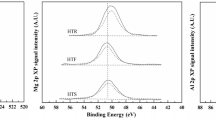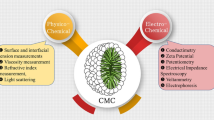Abstract
The kinetics of the oxidation of o-Cresol by cerium(IV) have been investigated spectrophotometrically at 298K in the absence and presence of sodium dodecyl sulfate (SDS) and polyethylene glycols (PEGs) in sulfuric acid medium to examine the catalytic behavior of SDS, PEG (600, 1500, and 4000), and the mixed systems of PEG 600, 1500, and 4000 with SDS. The reaction was first order with respect to [cerium(IV)] and fractional order with respect to [o-Cresol] and [H2SO4]. However, the effect of SDS catalysis was explained via Piszkiewicz’s cooperativity model to calculate the cooperative index (n) and dissociation constants (kD) of substrate–surfactant aggregates, while the catalytic activity of PEGs was also examined by use of the Benesi–Hildebrand model. In general, reaction rate enhancements have been observed in the oxidation of o-Cresol by cerium(IV) in the presence of SDS and PEG (600, 1500). On the other hand, the catalytic profiles of the various mixed PEG–SDS systems have shown a sudden increase in the observed rate constant (kobs) values even before the actual critical micelle concentration (CMC) of SDS. This premicellar catalysis can be interpreted on the basis of the formation of the active PEG–SDS aggregates at various [SDS] and [PEG]. A plausible mechanism of the oxidation reaction has been suggested; in addition, the major final product was salicylic acid, which is separated by column chromatography and tested by melting point, ultraviolet–visible, and FTIR spectra to compare with the original sample of salicylic acid.














Similar content being viewed by others
References
Ghosh A, Saha R, Mukherjee K, Sar P, Ghosh SK, Malik S, Bhattacharyya SS, Saha B (2014) Rate enhancement via micelle encapsulation for room temperature metal catalyzed Ce(IV) oxidation of p-chlorobenzaldehyde to p-chlorobenzoic acid in aqueous medium at atmospheric pressure. J Mol Liq 190:81–93. https://doi.org/10.1016/j.molliq.2013.10.029
Mehdi H, Bodor A, Lantos D, Horváth IT, De Vos DE, Binnemans K (2007) Imidazolium ionic liquids as solvents for Cerium(IV)-mediated oxidation reactions. J Org Chem 72:517–524. https://doi.org/10.1021/jo061909o
Chimatadar SA, Koujalagi SB, Nandibewoor ST (2001) Kinetics and mechanism of palladium(II) catalyzed chromium(VI) oxidation of mercury(I) in aqueous sulphuric acid. Transition Met Chem 26:662–667. https://doi.org/10.1023/A:1012019626879
Chimatadar SA, Basavaraj T, Nandibewoor ST (2002) Ruthenium(III) mediated Cerium(IV) oxidation of Thallium(I) in aqueous sulphuric acid-A kinetic and mechanistic study. Inorg React Mech 4:209–219. https://doi.org/10.1080/1028662021000062563
Yadav MB, Devra V, Rani A (2009) Kinetics and mechanism of silver(I) catalyzed oxidation of L-leucine by cerium (IV) in acid perchlorate medium. Physical Chemistry: An Indian Journal 4:21–26
Fawzy A (2016) Kinetic and mechanistic aspects of oxidation of aminotriazole formamidine by Cerium(IV) in aqueous perchloric and sulfuric acid solutions: a comparative study. J Solution Chem 45:246–264. https://doi.org/10.1007/s10953-016-0438-1
Sumathi T, Shanmugasundaram P, Chandramohan G (2016) A kinetic and mechanistic study on the oxidation of L-methionine and N-acetyl L-methionine by cerium(IV) in sulfuric acid medium. Arab J Chem 9:177–184. https://doi.org/10.1016/j.arabjc.2011.02.024
Fendler JH, Fendler EJ (1975) Catalysis in micellar and macromolecular systems. Academic press, New York, USA, pp 8–24
Menger FM, Portnoy CE (1967) Chemistry of reactions proceeding inside molecular aggregates. J Am Chem Soc 89:4698–4703. https://doi.org/10.1021/ja00994a023
Piszkiewicz D (1977) Positive cooperativity in micelle-catalyzed reactions. J Am Chem Soc 99:1550–1557. https://doi.org/10.1021/ja00447a044
Hassan M, Al-Dhoun M, Batineh Y, Najjar AA, Dahadha A, Ibrahim, QA (2021) Micellar and polymer catalysis in the kinetics of xidation of L-lysine by permanganate ion in perchloric acid medium. S Afr J Chem 75:73–79. https://doi.org/10.17159/0379-4350/2021/v75a8
Pare B, Kaur P, Bhagwat VW, Fogliani C (2004) Micelles in physical chemistry laboratory. surfactant catalyzed oxidation of glycine by acidic permanganate. J Korean Chem Soc 48:195–202
Mondal MH, Ali MA, Pal A, Saha B (2019) A review on micellar catalyzed oxidation reactions of organic functional groups in aqueous medium using various transition metals. Tenside Surf Det 56:516–525. https://doi.org/10.3139/113.110654
Tehrani-Bagha AR, Holmberg K (2013) Solubilization of hydrophobic dyes in surfactant solutions. Materials 6:580–608. https://doi.org/10.3390/ma6020580
Mallick K, Jewrajka S, Pradhan N, Pal T (2001) Micelle-catalysed redox reaction. Curr Sci 80:1408–1412
Kabir-ud-Din AMS, Khan Z (2005) Effect of anionic and cationic micelles on the oxidation of D-glucose by cerium(IV) in presence of H2SO4. Colloid Polym Sci 284:10–18. https://doi.org/10.1007/s00396-005-1301-x
Ghosh A, Saha R, Sar P, Saha B (2013) Rate enhancement via micelle encapsulation for room temperature metal catalyzed Ce(IV) oxidation of formaldehyde to formic acid in aqueous medium at atmospheric pressure: a kinetic approach. J Mol Liq 186:122–130. https://doi.org/10.1016/j.molliq.2013.07.003
Ghosh A, Das P, Saha D, Sar P, Ghosh SK, Saha B (2016) Rate enhancement via sodium dodecyl sulfate (SDS) encapsulation of metal-mediated cerium(IV) oxidation of D-mannitol to D-mannose at room temperature and pressure: a kinetic and mechanistic approach. Res Chem Intermed 42:2619–2639. https://doi.org/10.1007/s11164-015-2171-6
Itsuno S (2013) Polymer catalysts, in Encyclopedia of polymeric nanomaterials, S. Kobayashi and K. Müllen, Eds. Springer, Berlin, Heidelberg
Rajitha N, Shylaja S, Rajanna KC, Yadagiri B (2018) Polyethylene glycols as efficient catalysts for the oxidation of bicyclic monoterpenes by ceric ammonium nitrate in acetonitrile under Acid-Free conditions: kinetic and mechanistic approach. Int J Chem Kinet 50:383–396. https://doi.org/10.1002/kin.21168
Shylaja S, Rajanna KC, Ramesh K, Reddy K, Reddy PG (2013) Polyethylene glycols as efficient catalysts for the oxidation of xanthine alkaloids by ceric ammonium nitrate in acetonitrile: a kinetic and mechanistic approach. Adv Phys Chem 1–11. https://doi.org/10.1155/2013/835610
Jang HJ, Shin C, Kim KB (2015) Safety evaluation of polyethylene glycol (PEG) compounds for cosmetic use. Toxicol Res 31:105–136. https://doi.org/10.5487/TR.2015.31.2.105
Fruijtier-Pölloth C (2005) Safety assessment on polyethylene glycols (PEGs) and their derivatives as used in cosmetic products. Toxicol 214:1–38. https://doi.org/10.1016/j.tox.2005.06.001
Hutanu D, Frishberg MD, Guo L, Darie CC (2014) Recent applications of polyethylene glycols (PEGs) and PEG derivatives. Mod Chem Appl 2:1–6. https://doi.org/10.4172/2329-6798.1000132
Dahadha AA, Hassan M, Al-Dhoun M, Mfarej T, Abunuwar M, Batineh Y (2021) The oxidation of salicylic acid and acetylsalicylic acid by water-soluble colloidal manganese oxide in surfactant and polymer media: a kinetic and mechanistic approach. React Kinet Mech Catal 134:37–55. https://doi.org/10.1007/s11144-021-02083-9
Qiao L, Easteal AJ (1998) The interaction between triton X series surfactants and poly (ethylene glycol) in aqueous solutions. Colloid Polym Sci 276:313–320. https://doi.org/10.1007/s003960050245
Schwuger MJ (1973) Mechanism of interaction between ionic surfactants and polyglycol ethers in water. J Colloid Interface Sci 43:491–498. https://doi.org/10.1016/0021-9797(73)90395-0
Goddard ED (2002) Polymer/surfactant interaction: interfacial aspects. J Colloid Interface Sci 256:228–235. https://doi.org/10.1006/jcis.2001.8066
Dahadha A, Hassan M, Al-Dhoun M, Batineh Y, Abu-Halaweh M (2021) Kinetics of oxidation of aspirin by Ce(IV) in surfactant, polymer, and mixed surfactant-polymer media. Colloid Polym Sci 299. https://doi.org/10.1007/s00396-021-04849-y
Berg JM, Tymoczko JL, Stryer L (2002) The Michaelis-Menten model accounts for the kinetic properties of many enzymes. Biochemistry section 8.4. 5th edition New York: W H Freeman
Wright MR (2004) An introduction to chemical kinetics. John Wiley & Sons Ltd, England
Chaimovich H, Aleixo FMV, Cuccovia IM, Zanette D, Quina FH (1982) In solution behaviour of surfactants: theoretical and applied aspects, ed. Mittal KL, Fendler EJ Plenum Press, New York 2:949
Bunton CA, Gratzel M, Kalyanasundaram K (1991) (Eds.), Kinetics and catalysis in microheterogeneous systems, Marcel Dekker, New York 13
Pandey S, Upadhyay SK (2005) Effect of cationic micellar aggregates on the kinetics of oxidation of aminoalcohols by N-bromosuccinimide in alkaline medium. J Colloid Interface Sci 285:789–794. https://doi.org/10.1016/j.jcis.2004.01.085
Dey J, Sultana N, Kumar S, Aswal VK, Choudhury S, Ismail K (2015) Controlling the aggregation of sodium dodecylsulphate in aqueous poly(ethylene glycol) solutions. RSC Adv 5:74744–74752. https://doi.org/10.1039/c5ra13096d
Acknowledgements
The authors wish to convey their sincere thanks to Philadelphia University in Jordan for successfully conducting the all kinetic runs in the scientific laboratory.
Funding
Mohammed Hassan is grateful to IIE, New York, for granting him an SRF fellowship.
Author information
Authors and Affiliations
Corresponding author
Ethics declarations
Conflict of interest
The authors have no conflicts of interest to declare that are relevant to the content of this article.
Additional information
Publisher's Note
Springer Nature remains neutral with regard to jurisdictional claims in published maps and institutional affiliations.
Supplementary Information
Below is the link to the electronic supplementary material.
Rights and permissions
About this article
Cite this article
Dahadha, A.A., Hassan, M., Mfarej, T. et al. The effect of mixed sodium dodecyl sulfate–polyethylene glycol systems on kinetic of oxidation of o-Cresol by cerium(IV) in H2SO4 medium. Colloid Polym Sci 300, 177–190 (2022). https://doi.org/10.1007/s00396-022-04940-y
Received:
Revised:
Accepted:
Published:
Issue Date:
DOI: https://doi.org/10.1007/s00396-022-04940-y




